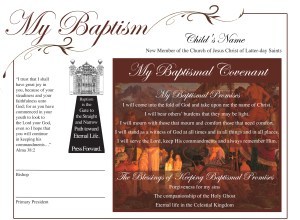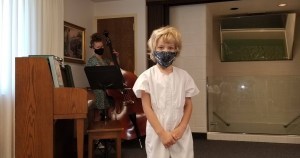We Teach Two Different Versions of the Baptismal Covenant at Primary
Several years ago, one of my first assignments as a new Primary Presidency member was to create a certificate for newly baptized children to hang on their wall. It would be a meaningful reminder of a sacred covenant. Also, it would be a $1 gift. Always resourceful and efficient (i.e., a bit lazy), my first act was to search the web for a memento someone else had already made that I could print. But I wasn’t finding what I needed. Other people had made them, but the covenant was wrong. Well, technically it was correct, but it was summarized and truncated like this:

The baptism memento I made for my Primary, featuring Alma’s version of the baptismal covenant
Take upon us the name of ChristAlways remember Jesus ChristKeep the commandmentsWhy was there no mention of mourning with those that mourn? Comforting those that stand in need of comfort? Bearing one another’s burdens? Standing as a witness of God?
At the time, the Primary curriculum was emphasizing how the baptismal covenant matched the covenant given in the Sacrament prayer (D&C 20:77,79), rather than going into the details of Alma’s sermon on baptism in the Book of Mormon (Mosiah 18:8-9). The curriculum varies year to year; last year’s Primary manual covered the Book of Mormon and emphasized Alma’s version of the baptismal covenant. This year, the curriculum is based on Doctrine and Covenants and focuses on how the sacrament prayer describes it.
Technically, all the good stuff found in Alma’s sermon falls under the umbrella of “keep the commandments.” While I favor keeping commandments in general, the baptismal covenant Alma described emphasizes certain commandments, specifically. I think there is a reason that Alma highlighted mourning with other people, comforting them, bearing each other’s burdens and standing as witnesses of God as the most relevant commandments to the first saving ordinance of the gospel. Jesus taught that the “first and great commandment” is to love God and that the second is to love our neighbors (Matthew 22:37-40). Alma’s sermon is pretty much a primer on following the first and second great commandments.
“Keep the commandments” is a nice, short statement to remember, but well near impossible to achieve. There are so many commandments, we are bound to flub them up! Talk of keeping commandments often digresses into listing rules, but the baptismal covenant Alma described wasn’t about rules. Jesus warned against fixating on rules. He taught by example that helping people in need was more important than following rules (Mark 2, John 5).
At baptism, a child doesn’t promise to serve a two-year, full-time mission; marry in the temple; pay 10% of their adult income to the church and attend church meetings every Sunday for the rest of their lives, accepting and magnifying every church calling offered to them. It wouldn’t be ethical to ask an eight-year-old to make those kinds of commitments, but a child can love God and the people around her.

My oldest child received one of the baptismal mementos I made when I was serving in the Primary presidency, with Alma’s version of the baptismal covenant printed on it.
My youngest child was baptized recently. Due to the Covid-19 pandemic, Primary had not convened for months. I floated the idea of holding off on the baptism. It had been so long since he’d been to church; did he even remember what baptism was all about? But he wanted to be baptized immediately. He loves God. He loves people. He was ready.



